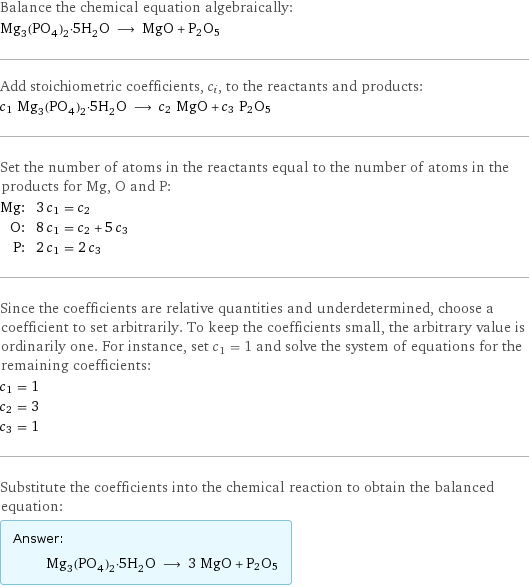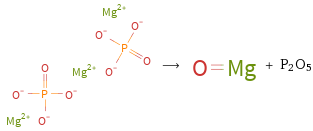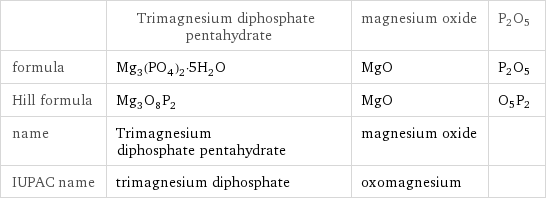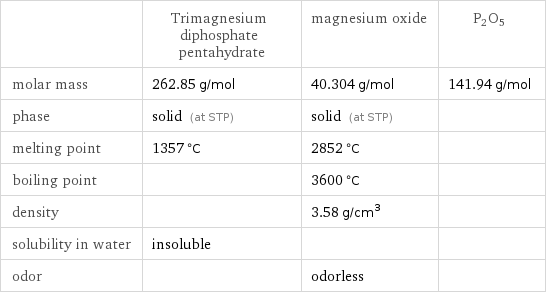Input interpretation

Mg_3(PO_4)_2·5H_2O Trimagnesium diphosphate pentahydrate ⟶ MgO magnesium oxide + P2O5
Balanced equation

Balance the chemical equation algebraically: Mg_3(PO_4)_2·5H_2O ⟶ MgO + P2O5 Add stoichiometric coefficients, c_i, to the reactants and products: c_1 Mg_3(PO_4)_2·5H_2O ⟶ c_2 MgO + c_3 P2O5 Set the number of atoms in the reactants equal to the number of atoms in the products for Mg, O and P: Mg: | 3 c_1 = c_2 O: | 8 c_1 = c_2 + 5 c_3 P: | 2 c_1 = 2 c_3 Since the coefficients are relative quantities and underdetermined, choose a coefficient to set arbitrarily. To keep the coefficients small, the arbitrary value is ordinarily one. For instance, set c_1 = 1 and solve the system of equations for the remaining coefficients: c_1 = 1 c_2 = 3 c_3 = 1 Substitute the coefficients into the chemical reaction to obtain the balanced equation: Answer: | | Mg_3(PO_4)_2·5H_2O ⟶ 3 MgO + P2O5
Structures

⟶ + P2O5
Names

Trimagnesium diphosphate pentahydrate ⟶ magnesium oxide + P2O5
Equilibrium constant
![Construct the equilibrium constant, K, expression for: Mg_3(PO_4)_2·5H_2O ⟶ MgO + P2O5 Plan: • Balance the chemical equation. • Determine the stoichiometric numbers. • Assemble the activity expression for each chemical species. • Use the activity expressions to build the equilibrium constant expression. Write the balanced chemical equation: Mg_3(PO_4)_2·5H_2O ⟶ 3 MgO + P2O5 Assign stoichiometric numbers, ν_i, using the stoichiometric coefficients, c_i, from the balanced chemical equation in the following manner: ν_i = -c_i for reactants and ν_i = c_i for products: chemical species | c_i | ν_i Mg_3(PO_4)_2·5H_2O | 1 | -1 MgO | 3 | 3 P2O5 | 1 | 1 Assemble the activity expressions accounting for the state of matter and ν_i: chemical species | c_i | ν_i | activity expression Mg_3(PO_4)_2·5H_2O | 1 | -1 | ([Mg3(PO4)2·5H2O])^(-1) MgO | 3 | 3 | ([MgO])^3 P2O5 | 1 | 1 | [P2O5] The equilibrium constant symbol in the concentration basis is: K_c Mulitply the activity expressions to arrive at the K_c expression: Answer: | | K_c = ([Mg3(PO4)2·5H2O])^(-1) ([MgO])^3 [P2O5] = (([MgO])^3 [P2O5])/([Mg3(PO4)2·5H2O])](../image_source/53031bac4849ac53378da0fa97f9d5c6.png)
Construct the equilibrium constant, K, expression for: Mg_3(PO_4)_2·5H_2O ⟶ MgO + P2O5 Plan: • Balance the chemical equation. • Determine the stoichiometric numbers. • Assemble the activity expression for each chemical species. • Use the activity expressions to build the equilibrium constant expression. Write the balanced chemical equation: Mg_3(PO_4)_2·5H_2O ⟶ 3 MgO + P2O5 Assign stoichiometric numbers, ν_i, using the stoichiometric coefficients, c_i, from the balanced chemical equation in the following manner: ν_i = -c_i for reactants and ν_i = c_i for products: chemical species | c_i | ν_i Mg_3(PO_4)_2·5H_2O | 1 | -1 MgO | 3 | 3 P2O5 | 1 | 1 Assemble the activity expressions accounting for the state of matter and ν_i: chemical species | c_i | ν_i | activity expression Mg_3(PO_4)_2·5H_2O | 1 | -1 | ([Mg3(PO4)2·5H2O])^(-1) MgO | 3 | 3 | ([MgO])^3 P2O5 | 1 | 1 | [P2O5] The equilibrium constant symbol in the concentration basis is: K_c Mulitply the activity expressions to arrive at the K_c expression: Answer: | | K_c = ([Mg3(PO4)2·5H2O])^(-1) ([MgO])^3 [P2O5] = (([MgO])^3 [P2O5])/([Mg3(PO4)2·5H2O])
Rate of reaction
![Construct the rate of reaction expression for: Mg_3(PO_4)_2·5H_2O ⟶ MgO + P2O5 Plan: • Balance the chemical equation. • Determine the stoichiometric numbers. • Assemble the rate term for each chemical species. • Write the rate of reaction expression. Write the balanced chemical equation: Mg_3(PO_4)_2·5H_2O ⟶ 3 MgO + P2O5 Assign stoichiometric numbers, ν_i, using the stoichiometric coefficients, c_i, from the balanced chemical equation in the following manner: ν_i = -c_i for reactants and ν_i = c_i for products: chemical species | c_i | ν_i Mg_3(PO_4)_2·5H_2O | 1 | -1 MgO | 3 | 3 P2O5 | 1 | 1 The rate term for each chemical species, B_i, is 1/ν_i(Δ[B_i])/(Δt) where [B_i] is the amount concentration and t is time: chemical species | c_i | ν_i | rate term Mg_3(PO_4)_2·5H_2O | 1 | -1 | -(Δ[Mg3(PO4)2·5H2O])/(Δt) MgO | 3 | 3 | 1/3 (Δ[MgO])/(Δt) P2O5 | 1 | 1 | (Δ[P2O5])/(Δt) (for infinitesimal rate of change, replace Δ with d) Set the rate terms equal to each other to arrive at the rate expression: Answer: | | rate = -(Δ[Mg3(PO4)2·5H2O])/(Δt) = 1/3 (Δ[MgO])/(Δt) = (Δ[P2O5])/(Δt) (assuming constant volume and no accumulation of intermediates or side products)](../image_source/bbb28d4b48c3d5b202176a786da46d3a.png)
Construct the rate of reaction expression for: Mg_3(PO_4)_2·5H_2O ⟶ MgO + P2O5 Plan: • Balance the chemical equation. • Determine the stoichiometric numbers. • Assemble the rate term for each chemical species. • Write the rate of reaction expression. Write the balanced chemical equation: Mg_3(PO_4)_2·5H_2O ⟶ 3 MgO + P2O5 Assign stoichiometric numbers, ν_i, using the stoichiometric coefficients, c_i, from the balanced chemical equation in the following manner: ν_i = -c_i for reactants and ν_i = c_i for products: chemical species | c_i | ν_i Mg_3(PO_4)_2·5H_2O | 1 | -1 MgO | 3 | 3 P2O5 | 1 | 1 The rate term for each chemical species, B_i, is 1/ν_i(Δ[B_i])/(Δt) where [B_i] is the amount concentration and t is time: chemical species | c_i | ν_i | rate term Mg_3(PO_4)_2·5H_2O | 1 | -1 | -(Δ[Mg3(PO4)2·5H2O])/(Δt) MgO | 3 | 3 | 1/3 (Δ[MgO])/(Δt) P2O5 | 1 | 1 | (Δ[P2O5])/(Δt) (for infinitesimal rate of change, replace Δ with d) Set the rate terms equal to each other to arrive at the rate expression: Answer: | | rate = -(Δ[Mg3(PO4)2·5H2O])/(Δt) = 1/3 (Δ[MgO])/(Δt) = (Δ[P2O5])/(Δt) (assuming constant volume and no accumulation of intermediates or side products)
Chemical names and formulas

| Trimagnesium diphosphate pentahydrate | magnesium oxide | P2O5 formula | Mg_3(PO_4)_2·5H_2O | MgO | P2O5 Hill formula | Mg_3O_8P_2 | MgO | O5P2 name | Trimagnesium diphosphate pentahydrate | magnesium oxide | IUPAC name | trimagnesium diphosphate | oxomagnesium |
Substance properties

| Trimagnesium diphosphate pentahydrate | magnesium oxide | P2O5 molar mass | 262.85 g/mol | 40.304 g/mol | 141.94 g/mol phase | solid (at STP) | solid (at STP) | melting point | 1357 °C | 2852 °C | boiling point | | 3600 °C | density | | 3.58 g/cm^3 | solubility in water | insoluble | | odor | | odorless |
Units
